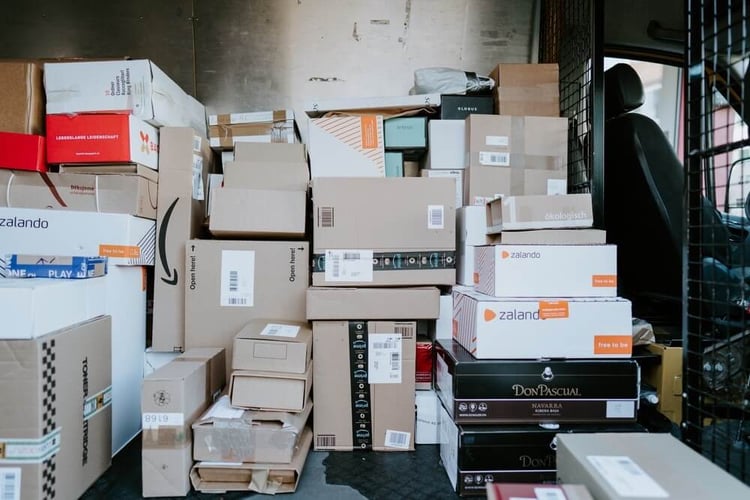
As we have learned from managing the Ecommerce boom in 2020, the adrenalin of ramping up adequately to get hundreds – or thousands – of shipments out every day also has a “hangover” feeling that comes from the Returns process.
Returns are an integral part of any DC operation because they are an integral part of policies that drive customer satisfaction. Businesses with generous returns policies make it easier for first-time customers to try them out because a “guarantee” eliminate the risk for the customer. Depending on the industry, return rates can vary wildly, with some categories of clothing exceeding 40%.
But even though Returns is an integral part of an Ecommerce operation, it’s generally an overlooked part of the business in regards to the typical focus on efficiency. Here are some key insights to help you get your Returns area running as efficiently as the rest of your operation:
1. Create a Dedicated Receiving Process for Returns
One important step to reduce the messy part of Returns up front is ensuring they can be Received in batches, together, AND separately from your other incoming shipments. Work with your Marketing and Sales Departments to make the process smooth end-to-end by having them provide the labeling method and a dedicated “address” that your shipper can use to keep the Returns separate from other incoming shipments (i.e. “Returns Department”).
Remember, even if you use just one shipper for your outgoing packages, you will likely get Returns delivered from USPS, UPS, Fedex and more. They won’t coordinate for you, but you should have relationships with all of them so you can set your preferences and work together on getting your Returns delivered in a manner that benefits you the most (i.e. time of day, racked or binned together, specific bay doors, etc.).
2. Create a Team of Crack Returns Specialists
By nature, Returns is a cost-center for your business (though indirectly it can be a profit center). But in reality, it is also a skill position for your team, because the identification, sorting, restocking or disposing of your returned merchandise can impact the financial KPIs of your Returns area significantly.
 While many of the steps can be trained pretty quickly, evaluating returned product and deciding how it should be handled is often a highly skilled part of the job in returns. For example, a clothing retailer with a generous return policy (unconditional), would have Returns staff with trained noses to identify if a product has been worn, or not, or if it has been washed, or just simply tried on. The result of their “sniff test” will determine if it 1) goes back to stock 2) goes into an overstock or thrift sale, or discarded. If it was returned for a manufacturing flaw, it would need to be recorded or sent back to the manufacturer.
While many of the steps can be trained pretty quickly, evaluating returned product and deciding how it should be handled is often a highly skilled part of the job in returns. For example, a clothing retailer with a generous return policy (unconditional), would have Returns staff with trained noses to identify if a product has been worn, or not, or if it has been washed, or just simply tried on. The result of their “sniff test” will determine if it 1) goes back to stock 2) goes into an overstock or thrift sale, or discarded. If it was returned for a manufacturing flaw, it would need to be recorded or sent back to the manufacturer.
By being quick and effective at identifying, repackaging and restocking returned items your customers will benefit from better fulfillment rates and the returns process earns its keep.
3. Document Your Process and Build On It
Like any other critical process area, Returns deserves its own documented workflows, KPIs, best practices and training. Your industry should already have some leaders who are doing this right, so re-inventing the wheel shouldn’t always be required.
Some of the steps and KPIs your process may be required could include:
- Traffic Distribution – like incoming orders and outgoing shipments, Returns will develop its own patterns with a “peak” day each week which you can staff around.
- Intake – how quickly incoming packages are opened, identified and prepped for inspection.
- Product Verification – as mentioned in #2, documenting the requirements and criteria for identifying the state of the returned product and classifying its next destination.
4. Double the Fun in Returns with Q&A
 One aspect of Returns that is not always appreciated or recognized is the overlap in skills and and processes that are possible with a Quality Control process. The same team can apply the same training to incoming product at the Receiving dock to verify contents and identify manufacturing defects or other issues. This is usually done by using a pre-determined guide that indicates how many items from a shipment (or a % of the total) that need to be inspected. This guide is usually broken down by manufacturer – as the inspection requirements are usually set based on the contract with the manufacturer.
One aspect of Returns that is not always appreciated or recognized is the overlap in skills and and processes that are possible with a Quality Control process. The same team can apply the same training to incoming product at the Receiving dock to verify contents and identify manufacturing defects or other issues. This is usually done by using a pre-determined guide that indicates how many items from a shipment (or a % of the total) that need to be inspected. This guide is usually broken down by manufacturer – as the inspection requirements are usually set based on the contract with the manufacturer.
For example, if Manufacture A making sweaters is under contract to deliver product with a 92% pass rate, then a shipment of 500 sweaters equally divided among 5 colors and 5 sizes each would have some percentage - say 10% - required for Q&A, then the Returns team would receive the pallet(s) from Receiving (PRIOR to putaway) and pull 2 of each color and size and inspect each of them for a predetermined list of areas to inspect (i.e. seams, color consistency, collar, elastics, etc.). If more than eight of them “fail” inspection, then the manufacturer contract might indicate to return the whole shipment, or just credit you for the percentage failing.
5. Or Just Hand it to the Pros
Finally, there are other options. Just like many businesses have discovered the value of Third Party Logistics partners (3PLs) for their regular outbound shipments, 3PLs can handle the Returns process too. While it does create another step in linking systems and managing a process outside of your own facilities, the benefits are worth if it means taking advantage of their existing systems, processes and training.
 While many 3PLs are focused on managing the outbound business as their core business and handle returns as an additional add-on service, there are other providers who are dedicated to Returns management or the entire “Reverse Logistics” process. While the cost of using outside services is higher than doing it in-house, their expertise will factor into your business immediately, maximizing your ROI on the Returns process and providing you with clarity on the relevant KPIs that will give you the best insights into how that part of your business is functioning.
While many 3PLs are focused on managing the outbound business as their core business and handle returns as an additional add-on service, there are other providers who are dedicated to Returns management or the entire “Reverse Logistics” process. While the cost of using outside services is higher than doing it in-house, their expertise will factor into your business immediately, maximizing your ROI on the Returns process and providing you with clarity on the relevant KPIs that will give you the best insights into how that part of your business is functioning.
Services for these businesses could include skills like
- Test, repair and refurbishment of products
- Valuation, appraisal and sales of product not going back into circulation
- Inventory tracking, cash flow, freight & labor
- Vendor management for returns, related fees, etc.
- Recycling options where necessary
2020’s Changes Are Here to Stay, So Are Returns
As we’ve repeated so many times this year, the band-aids we all applied back in Spring to get us through the initial inconvenience have morphed into the Macgyver solution using our wits, spare parts and blow-torches but not need to morph again into our long-term solution that meets the challenge as professionally as we manage the other parts of our warehouse.
Learn more about the Returns process from our archives on Reverse Logistics.
